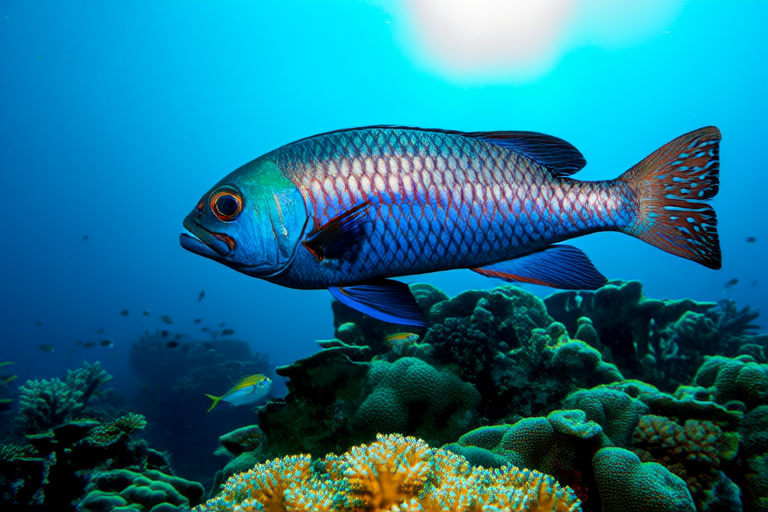Top 10 Fascinating Facts About Parrot Fish You Need to Know
Parrotfish are some of the most colorful and intriguing creatures that inhabit our oceans. Found in tropical and subtropical waters around the world, these fish have captivated the imagination of divers and marine biologists alike. From their vibrant colors to their unique sleeping habits, there’s much more to learn about these fascinating fish. Here are the top 10 fascinating facts about parrot fish that you need to know.
1. A Diverse Array of Species
The family of parrotfish, known as Scaridae, consists of approximately 90 species. These species vary greatly in size, coloration, and behavior. The smallest parrotfish can be as tiny as 6 inches (15 cm), while the largest can reach up to 4 feet (1.2 meters) in length. Their diversity is further highlighted by their striking array of colors, ranging from bright blues and greens to deep reds and oranges. Each species has its own unique pattern, making them easily distinguishable from one another.
2. Unique Teeth Arrangement
One of the most distinctive features of parrotfish is their beak-like mouth, equipped with rows of strong teeth. These teeth are fused together, forming a beak-like structure that resembles that of a parrot, hence the name. This specialized arrangement allows parrotfish to scrape algae off coral reefs and other rocky surfaces. Interestingly, they also have pharyngeal teeth located at the back of their throats, which grind down the coral and algae before it is expelled. This unique adaptation plays a crucial role in maintaining the health of coral reefs.
3. Habitat and Distribution
Parrotfish are primarily found in the tropical and subtropical waters of the Atlantic, Pacific, and Indian Oceans. They prefer shallow, warm waters where coral reefs are abundant. These reefs provide both food and shelter for parrotfish, making them ideal habitats. Many species of parrotfish are also known to reside in lagoons and seagrass beds, further extending their range. Despite their preference for warm waters, certain species have adapted to cooler climates, expanding their distribution to include temperate regions.
4. Role in Coral Reef Ecosystems
Parrotfish play a vital role in maintaining the health and biodiversity of coral reef ecosystems. By grazing on algae, they prevent overgrowth, which could otherwise smother the corals. This process helps to maintain the delicate balance between algae and coral, ensuring the survival of the reef. Additionally, when parrotfish digest the coral and algae, they excrete fine sand. This sand contributes to the formation of beaches and islands, further demonstrating the significant impact these fish have on their environment.
5. Colorful Transformations
Parrotfish are known for their ability to change color throughout their lives. Juvenile parrotfish often have drab, camouflaged coloring that helps them blend into their surroundings, protecting them from predators. As they mature, they undergo a series of color changes that culminate in their adult coloration. Some species even display dramatic transformations during breeding season, with males developing brighter hues to attract females. These color changes are driven by hormones and are an essential part of their lifecycle.
6. Sleep Behavior: Creating Mucus Bubbles
Perhaps one of the most peculiar behaviors of parrotfish is their nightly creation of mucus bubbles. Before going to sleep, many species of parrotfish secrete a thick, protective mucus cocoon around themselves. This mucus acts as a barrier, masking the fish’s scent from potential predators like sharks. It also contains compounds that may help protect the fish from harmful parasites and bacteria. This unique adaptation highlights the ingenuity of marine life in adapting to their environments.
7. Reproduction and Social Structures
Parrotfish exhibit a variety of reproductive strategies, depending on the species. Most species are protogynous hermaphrodites, meaning they start their lives as females and later transition to males. In some species, this transition occurs after they have reached a certain size or age. Others form harems, with one dominant male mating with several females. During breeding season, males often engage in elaborate courtship displays, showcasing their vibrant colors and performing acrobatic maneuvers to attract a mate.
8. Camouflage Techniques
Despite their vibrant colors, parrotfish have developed various methods of camouflage to avoid detection by predators. Some species have evolved patterns that mimic the texture of coral or rock, allowing them to blend seamlessly into their surroundings. Others change color to match their environment, becoming almost invisible to the naked eye. This ability to adapt their appearance is a testament to the complexity and adaptability of marine life.
9. Impact of Human Activities
Unfortunately, human activities such as overfishing and habitat destruction pose significant threats to parrotfish populations. Many species are targeted for their meat, and their habitats are being damaged by pollution and climate change. The loss of parrotfish can have far-reaching consequences for coral reef ecosystems, as they play a critical role in maintaining the balance between algae and coral. Conservation efforts are underway to protect these vital fish and preserve the health of the oceans.
10. Cultural Significance
Parrotfish hold cultural significance for many coastal communities around the world. In some Polynesian cultures, they are considered sacred and are featured in traditional art and stories. Their vibrant colors and unique behaviors have inspired artists and writers for centuries. Additionally, parrotfish have been used as a food source for thousands of years, with some species being highly valued in local cuisines. Their importance extends beyond biology, touching on aspects of culture and history.
In conclusion, parrotfish are truly remarkable creatures that offer a glimpse into the wonders of marine life. From their unique physical adaptations to their vital role in coral reef ecosystems, these fish continue to fascinate and inspire. Understanding and appreciating the complexities of parrotfish can help us better protect these important members of our oceanic communities. By learning about their behaviors, habitats, and challenges, we can work towards preserving the delicate balance of life in our oceans.
